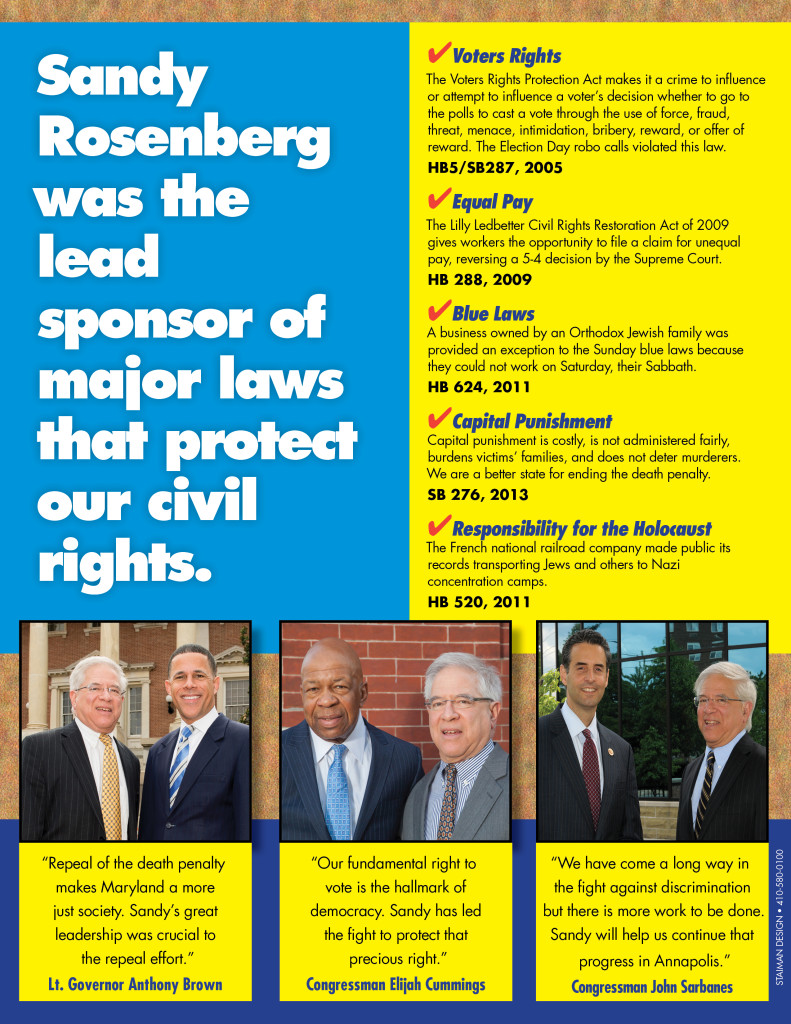Category: Uncategorized
Community Projects Brought to Reality
Grove Park Elementary/ Middle School and the Bluford Drew Jemison STEM Academy-West are Staying Open!


“It’s never over.”
“I couldn’t afford to lose my son too.”
“It’s never over.”
“Invest in us. It will help a lot of people.”
The three witnesses were testifying for my bill creating programs for survivors of homicide victims.
Maryland would be the first state to do this after repealing the death penalty.
Governor O’Malley put $500,000 for this purpose in his budget, fulfilling a commitment he made last year.
Today’s testimony brought back the emotions I felt during the repeal debate.
Only one task remains: persuading the Governor to commute the sentences for the men still on death row to life without the possibility of parole.
The Work Back Home
I sweat the details.
Four schools in the 41st District will be renovated in the first year of the $1 billion plan that will eventually transform every school in the City.
Senator Lisa Gladden, Delegates Jill Carter, Nathaniel Oaks, and I have attended planning meetings with students, their family members, and neighbors at Arlington and Pimlico Elementary/Middle Schools, Lyndhurst Elementary, and Forest Park Senior High. 3,000 square feet in each facility will be designed for community use.
A certain portion of slots revenue is allocated for economic and community development in the neighborhoods surrounding Pimlico Race Track.
In Northwest Baltimore, we’ve worked with neighborhood leaders to help them determine how $1.5 million will be spent. Parking for patrons of the Reisterstown Road Enoch Pratt Library branch, improvements to Luckman and Northwest Parks, and construction of the Hatzalah Community Center are some of the uses to which this money will be put.
Major renovation of Park Heights has also begun with this money, and Liberty Heights neighborhoods will benefit when the Baltimore City facility opens next year.
Our economy and our environment require a 21st Century mass transit system. On its way from Social Security in Woodlawn to Bayview Hospital in East Baltimore, the Red Line will run through the Edmondson Avenue corridor.
Where stops are located and the safety of pedestrians crossing Edmondson Avenue are crucial details. So are jobs. At our urging, a job forum will be held at the Westside Skills Center on Saturday.
After the bill passes in Annapolis, there’s a lot of work to do back home.
Counting, on the bench and in the House
At the Supreme Court today, much of the discussion dealt with what I do for a living.
The legal question was this: If the Court finds that the individual mandate is unconstitutional, what is the effect on the other provisions of the health care law?
Are all of the other parts of the law nullified? Some? None?
Phrased another way, should the judiciary revise the legislation or should the Congress, which wrote it in the first place?
None of the justices has ever run for office or had to count to a number higher than five to reach a majority.
The late Justice William Brennan reportedly said that counting to five is the most important principle of constitutional law because five votes constitute a majority on the Supreme Court.
Several of the Justices spoke today of their need for a test, an objective standard that would apply to similar cases in the future. (They also made clear their less than favorable view of the legislative process, as today’s transcript demonstrates.)
In Annapolis, our guiding principles are our assessment of sound public policy and how to address the ideological and political needs of 71 members, a majority of the House of Delegates.
No joke and crossing over to dry land
This is how our debate began on the bill to create a health exchange, where consumers can evaluate health insurance policies. The exchange would implement the Affordable Care Act.
“When I was driving here, I heard something on talk radio,” stated a Republican delegate.
“Many people consider that entertainment,” responded the Democratic floor leader for the legislation.
What followed was entertainment only if you’re amused by excessive and misleading rhetoric.
My Republican colleagues declared:
“This bill takes us down the dark night of socialism.”
“This won’t solve our uncompensated care problem because the people in emergency rooms are not lawfully present in this country.”
People will still be buying their health insurance from private companies. The Congress did not nationalize the industry.
Far too many of the people seeking care at an emergency room don’t have health insurance on the job. The vast majority of them are citizens of this country.
That’s no joke.
—-
I now have two file cards in my breast pocket.
One lists the 14 bills or issues I’m working on that have passed the House of Delegates and will avoid the delay of the Rules Committee.
The other has my five bills still waiting for the Red Sea to part in the House so that they can cross over to the dry land of the Senate.
Number one in a hurry
I was going to ask a question about the Red Line.
The proposed mass transit line runs through the heart of the Edmondson Avenue neighborhoods I represent.
The hearing was on the Governor’s gas tax bill, and I was going to make the point that the Red Line could not be built unless we had additional revenue.
Then Mayor Stephanie Rawlings-Blake testified that if the City does not receive more funding this session, it “will likely be forced to close as many as 15 bridges to traffic within the next two to three years.”
I raised my eyebrows.
The Mayor noticed.
“That was not a skeptical response,” I told her and the audience. “It was an ‘Oh, wow!’”
Baltimore would no longer rank 16th on the list of congested metropolitan areas.
We would be number one in a hurry.
The devil is in the details, as it is with most legislation, but a 21st Century transportation system is an investment we must make.
March 2 – Scholars and op-eds
March 1 – A very good sign and a car wash
The full text and a new low
Perhaps his stomach discomfort prevented Senator Santorum from reading beyond the semicolon.
The third paragraph of then-Senator Kennedy’s speech to the Houston Ministerial Association in 1960 begins with the words that upset Mr. Santorum.
I believe in an America where the separation of church and state is absolute;
The full paragraph reads as follows:
I believe in an America where the separation of church and state is absolute; where no Catholic prelate would tell the President — should he be Catholic — how to act, and no Protestant minister would tell his parishioners for whom to vote; where no church or church school is granted any public funds or political preference, and where no man is denied public office merely because his religion differs from the President who might appoint him, or the people who might elect him.
The relationship between church and state in the public square is a complex one. Before the decade is over, the Supreme Court will be asked to decide whether a religious entity’s employees are entitled to health care inconsistent with their employer’s beliefs or whether a same-gender married couple can be denied recognition or service by a religious institution or a devout individual.
By misleading the public as to the full content of what Senator Kennedy said and then characterizing his reaction in such a base manner, Senator Santorum has reached a wretchedly new low in campaign rhetoric.










